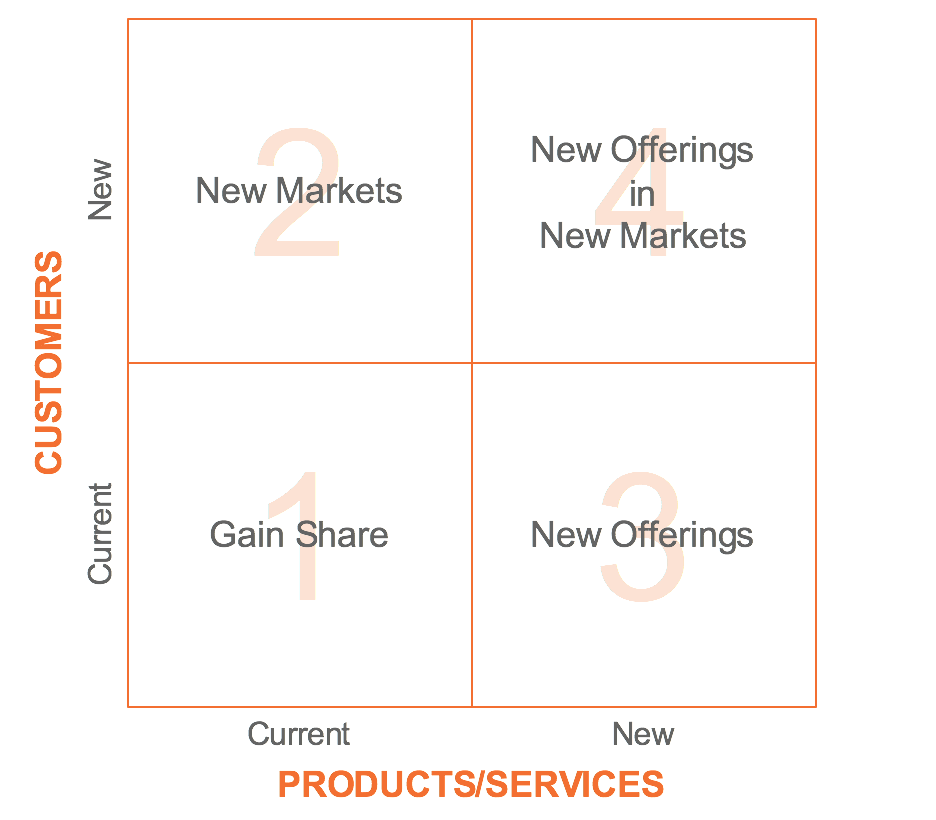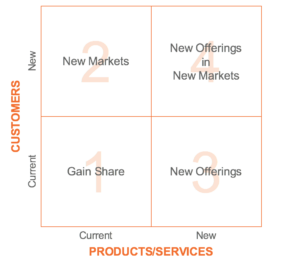Part 3 of 5
(This post was originally appeared in my previous blog in 2016).
In Your Innovation Roadmap, Part 1, I introduced the innovation matrix (featured above) and covered Quadrant 1: gaining market share. In Your Innovation Roadmap, Part 2, I covered Quadrant 2: bringing your current offerings to new customers. In this post, I’ll cover Quadrant 3: bringing new offerings to existing customers.
QUADRANT 3: NEW OFFERINGS
As mentioned in part 2, companies are often started with a specific problem or customer in mind. In a product-oriented company like technology or CPG (consumer packaged goods), the problem the founder set out to solve may be something that she or he personally experienced. In a services-oriented company, such as a management consultancy, marketing communications agency or law firm, the customer that the founder set out to support may be based on his or her expertise. Eventually, though, the firm reaches a market share with its original target audiences (Quadrant 1), that it needs to look into other areas for growth and innovation opportunities. Identifying new products/services to offer your existing customers is one key opportunity for innovation. Let’s look at a few approaches.
Adjacent Offerings. Adjacent offerings are wholly new products/services that relate to the core offering your customers are already purchasing from you. For our first example, I’ll turn to Nike again. As we saw in part 2, once Nike grabs a foothold with a new customer segment (for example: golfers) by adapting its core product (the athletic shoe) for that segment, Nike looks to expand in that customer segment by offering adjacent products. Once customers see Nike as a maker of quality golf shoes, it’s not a stretch for customers to think that Nike can also provide other quality golf apparel such as pants, shorts, shirts and hats. Later, if customers are already purchasing their golf apparel from Nike, why wouldn’t they also purchase utility gear like golf gloves, balls and clubs from Nike as well? In this case the core customer is the golfer, and the core offering is the golf shoe. Nike expands by offering the golfer adjacent golf products, such as apparel and gear.
The beer, wine and spirits industry also gives us an example of how this works. Let’s consider the well-known wine brand Jacob’s Creek. While the Gramp family has been making wine in the area known as Jacob’s Creek in Australia since 1847, it didn’t launch its first Jacob’s Creek brand wine until 1976. It’s first offering was a vintage blend of Shiraz, Cabernet Sauvignon and Malbec. But, today, Jacob’s Creek offers a wide range of varietals, including bottles of Shiraz, Cabernet Sauvignon, Malbec, Pinot Noir, Riesling and more. Most winemakers follow this same pattern: launch with a specific varietal at a specific price point that targets a specific segment of wine-drinker. Then, the brand expands into other varietals at similar price points for that same wine-drinking segment. These other wine varietals are adjacent products to the original varietal.
Consider the Austin, TX spirits brand, Deep Eddy Vodka. Its original product was a flavored vodka called Deep Eddy Sweet Tea. Once Deep Eddy got traction in the vodka market with its sweet tea flavored vodka, it wasn’t a stretch to expand into other flavors. Today, Deep Eddy offers a variety of flavors, including straight vodka, grapefruit, lemon, cranberry and peach. Founded in 2009, Deep Eddy Vodka was acquired for nearly $400 million in 2015, according to a report in Fortune, growing revenues by following a Quadrant 3 innovation strategy.
Finally, consider the Amazon Kindle. Instead of purchasing physical books and paying to ship each to customer’s homes, Amazon developed the Kindle e-reader – an innovative, hand-held device on which customers can download digital versions of books, newspapers, magazines, etc. Amazon developed this product for its core, existing customer (readers) and provided these customers a wholly new way to consume its core product (books) and other print products.
Value-Added Offerings. Unlike adjacent offerings, which require bringing wholly new products to your customers, value-added offerings are new features or services that you introduce on top of the core offering. This is common in the tech industry. Let’s take social media software as an example. The core offering for platforms like Sysomos, Radian6 and Crimson Hexagon is aggregating publicly available social media data and enabling customers (i.e. brands and the agencies that serve them) to analyze that data to gain insights about the brand’s audiences. While the core offering is the software platform itself, which customers pay an annual fee for, not all customers have the expertise or bandwidth to analyze the data that the platform offers. Thus, these software companies offer the value-added service of providing analyst support for a certain number of hours per month. A brand can use this analyst’s time to provide ad hoc analyses or even a regular cadence of reporting. This service is a fairly minimal additional cost on top of the annual software license. Similarly, companies like Spredfast and Sprinklr, whose core product is managing the publishing process for brands’ social media channels, offer value added services of having analysts that can review data and provide reporting, as well as social media strategists that can advise clients.
Perhaps my favorite example of value-added offerings comes from Amazon and its Prime membership. While Amazon began by selling books online, the company quickly grew to offer an expansive array of products that could be delivered to customers’ homes, giving customers a legitimate alternative to trekking to Walmart, Target, CostCo, or any number of other big-box and niche retailers. For power users that were frequently purchasing items from its website, Amazon launched Prime – a $99 per year (or $10.99 per month) membership that provides perks like free two-day shipping for eligible purchases, unlimited streaming of TV shows and movies on Prime Video, and the ability to borrow books from the Kindle Owners’ Lending Library. Customers that frequently purchase products from Amazon understand the rush that one gets from knowing that your purchase will be delivered in just two days. Customers paying $9.99 or more per Kindle book realize that all it takes is reading two or more books per month to capture the savings from borrowing books from the Kindle Owner’s Lending Library through Prime vs. buying individual books. Prime has been a phenomenal way for Amazon to hook its customers into using its offerings even more.
QUADRANT 4: NEW OFFERINGS IN NEW MARKETS
In the next post in this series, I’ll cover Quadrant 4 strategy. This is arguably the toughest innovation strategy, as it requires the greatest leap in imagination and courage in financial investment.
To read about Quadrant 1 – grow market share – click here.
To read about Quadrant 2 – new markets – click here.
(This post was originally appeared in my previous blog in 2016. I posted it here because the Innovation Roadmap Framework is timeless and still relevant today in 2024—though this post could be updated with some newer examples. If you have examples of companies that fit the Gain Share quadrant, and you’d like me to write about it, let me know in the comments.)




